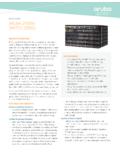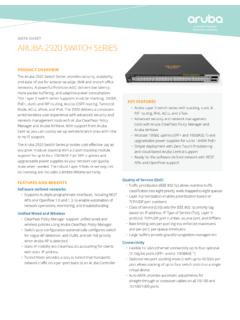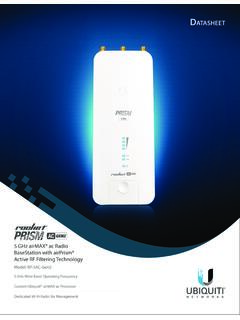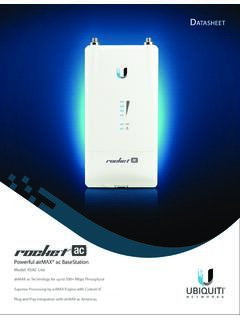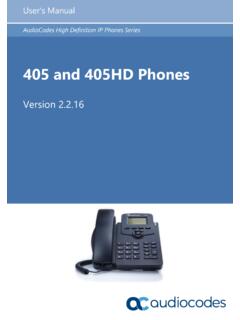Transcription of A Decentralized Exchange (DEX)
1 A Decentralized Exchange (DEX) That is driven by the Automated Market Maker (AMM) protocol , with the aim to provide liquidity to Cardano Blockchain projects that issue native WHITEPAPERVERSION OF CONTENTSA bstract ..3 Introduction ..4 Why DOEX is on Cardano blockchain? ..6 Cardano vs Ethereum ..7 ADA-ERC20 token Market Maker (AMM) ..10 Decentralized Cardano Projects are Overcoming the Concurrency Issue ..12 Market analysis (DeFi) ..14 Tokenomics ..15 Features ..16 Utility of the Token ..17 Roadmap ..18 Disclaimer ..193 ABSTRACTD ecentralized Exchanges or DEX perform the same function as their centralized counterparts. However, with DEX, users only interact with self-enforcing smart contracts to carry out secure and non-custodial transactions without the need of centralized third parties. This document introduces and describes DOEX a Cardano Blockchain-based Decentralized Exchange that uses Automatic Market Making protocols to execute transactions.
2 DOEX striking features include multiple pricing functions for a single liquidity pool, trade routing , instant price feed via on-chain price oracle, and automatic babel fees redemption for Stake Pool Operations (SPOs) that are Cardano one of the top performing blockchain networks, Cardano is yet to have a native Decentralized Exchange like those seen in other blockchain networks. This means that there is no Exchange list for tokens of projects that are based on Cardano Blockchain. Interestingly, this will soon become a thing of the past as DOEX is set to be the first Cardano Blockchain-based DEX with which liquidity will be provided to native assets on its network. The Cardano Blockchain update referred to as Mary Hard Fork that was completed on the 1st of March allows anyone to create native cryptocurrency assets on the blockchain. As such, it allows Cardano to have multi asset support and users can create custom tokens as well as execute transactions directly on the Cardano Mary Hard Fork, Cardano blockchain now offers several tokenization options and supports the blockchain to provide transactions that involve several asset types at the same time.
3 Native support of tokens is an important leverage for developers as it saves them the stress of using smart contracts to create custom assets or transactions. With this, the transfer of asset ownership is tracked by the accounting ledger thus removing the complexity, errors and security vulnerabilities from the equation in a cost-efficient manner. More precisely, native tokens on the Cardano Blockchain do not require the extra efforts that come with the creation of smart contracts to transfer their value and users can carry out transactions and burn their tokens without incurring smart contract transaction fees or adding event-handling logic to track update enables the creation of fungible and non-fungible tokens, which in turn enables users to create custom payment asset, stable coins pegged to fiat currencies, assets to represent intellectual property (IP), etc. These assets can then be used to seamlessly carry out transactions.
4 There are three ways by which assets can be created on the Cardano Blockchain. They include: Cardano Command Line interface (CLI); Token Builder graphical user interface (GUI); Daedalus wallet. The lifecycle of the native assets is made up of 5 phases: Minting; Issuance; Using; Redeeming; use of Cardano Command Line Interface (CLI) involves the technical know-how of setting up and operating the Cardano node as well as having the knowledge of handling transactions and managing wallet addresses and technical values. The GUI token builder on its own makes token creation and deployment seamless and facilitates token creation for Decentralized Applications (DApps) other specialized forms of tokens like NFTs, and fiat-pegged stablecoins. Daedalus and Yoroi wallets allow users to make use of existing assets for payments and purchases or can be created on Cardano by taking advantage of the features brought by Goguen era developments like Mary hard fork, Plutus and Marlowe - all of which are significant developments in the capabilities of Cardano.
5 More specifically, Plutus is a smart contract language and execution platform that consists of On-chain (on Cardano Blockchain) and Off-chain (on the user s machine) branches and uses the Haskell programming language. It allows the use of Alonzo update - as depicted in the final phase of Goguen on the roadmap of Cardano. Goguen will also deliver other core offering improvements, most importantly - multi-asset ledgers. The Alonzo update or hardfork brings about new and promising features to the Cardano Blockchain as it will enable smart contracts on the network via the integration of Plutus scripts. Alonzo adds a lot of opportunities for businesses and developers by facilitating the development of Decentralized Finance (DeFi) focused DApps and smart contracts. Alonzo brings a systematic approach that is based on verification and formal methods to extend the simple multi-signature scripting language used in Cardano Shelley.
6 Being an updated and extended effort on the Plutus smart contract language, Multisig ensures more efficient and stable scripting scripting is facilitated by Alonzo via the use of an extended model of unspent transaction output (eUTXO). This is made possible by using the hard fork combiner technology of IOHK - the parent infrastructure research and engineering company overseeing Cardano. This leads to efficient smart contracts that facilitate seamless and efficient automated assets trading applications and large cash movements. Apart from this, developers are equipped with tools to experiment, validate, and customize Cardano transactions. The APIs library will be expanded so that it can allow the deployment and operations of Plutus Core code while communicating with wallets and the distributed update is the precursor of the Alonzo update, and it allows users to use their wallet to receive both ADA and several other assets on the Cardano network.
7 The advent of Daedelus brings about the switch from platform s stake pools to community-led stake pool DOEX IS ON CARDANO BLOCKCHAIN?Like other blockchains, Cardano has several advantages. It is scalable, fast, has low transaction fees that can be paid with the same token sent. Although blockchains like Ethereum have a higher degree of acceptance than Cardano, we trust in the Cardano Blockchain potential to attract devel-opers and new venture capitalists which will catapult its adoption in the near addition, Cardano has a layered blockchain architecture that is composed of two main elements, the Cardano Settlement Layer (CSL) and Cardano Computational Layer (CCL), which makes it truly of the other existing blockchain platforms only have a single layer, which leads to scalability issues and often causes network congestion, slows down transactions and leads to higher network fees. Ethereum processes approximately 15 transactions per second (TPS).
8 This small amount of TPS makes the network slow and congested within a short time. Cardano on the other hand does not have these scalability issues. Simulations have shown that each Hydra head of the Cardano network can currently process about 1,000 transactions per second. This can be combined with 1,000 stacking pools, each of which processes 1,000 TPS. As such Cardano could achieve up to 1 million transactions per second which makes it super-fast at executing transactions at a very low network fee. Cardano and Ethereum networks have very similar properties. This includes ease of creation of smart contracts and building Decentralized applications (DApps). However, the philosophical no-tions of their creation and their design viewpoints are quite VS ETHEREUMS eptember 27th, 2017 Technologists Charles Hoskinson and Jeremy primary function of Cardano is to facilitate operations in its native token - ADA and to empower the developer community to build secure decentral-ized applications with amazing use emphasizes an approach that is purely based on research with the aim to facilitate mainstream adoption of the uses mathematically verified codes to provide users and developer community with excellent optimizations that are grounded in scientific Cardano Network is managed and supervised by three institutions.
9 They include:1. Cardano Foundation: responsible for the management of all aspects of the network s IOHK: created and designed the blockchain and its proof-of-stake , 2013 Vitalik Buterin, Anthony Di, Charles Hoskinson, Mihai Alisie & Amir aim of Ethereum aimed is to be-come a global, open-source platform for the creation of custom assets and various uses the offers several other Decentralized products and use cases apart from finance Ethereum was adopted by various blockchain projects during the ICO rush to raise funds for their currently most popular use of Ethereum is the creation of Decen-tralized Finance applications. Which is aimed at decentralizing core traditional financial use cases like lending/bor-rowing and removing centralized third parties and middlemen such as banks or mainstream financial institutions from objective of Ethereum is to be a global launchpad blockchain project where everyone can launch and run an pursue this objective, Ethereum sold 72 million Ether (ETH).
10 It s native network has a brilliant com-munity of developers, who actively ETHFOUNDEDCREATORSVISIONLAUNCH & ISSUANCETICKER8To make the network secure, Cardano uses a Proof-of-Stake-like consensus mechanism named Ouroboros. With it, users earn newly minted ADA when they validate is divided into epochs and slots by Ouroboros and the epochs are wide time frames while slots are 20-second increments within the each slot, a leader is selected and he is responsible for selecting the blocks that are added to the the end of an epoch, the previously selected slot leaders will choose the leader of the next epoch among is the native currency that drives Cardano and it is minted on every block. It is also the means by which slot leaders are rewarded for transaction has a limited supply. This means that its total supply is capped at 45 billion. As at January 2021, 31 billion ADA were in circulation and the 14 billion tokens that are left will be issued via contracts are written by devel-opers for the creation of DApps.
